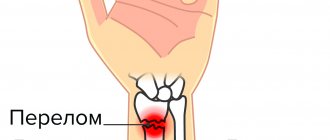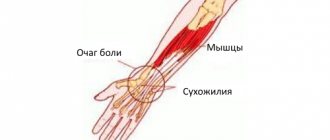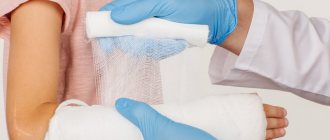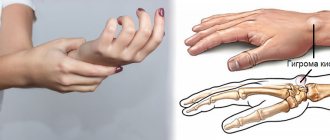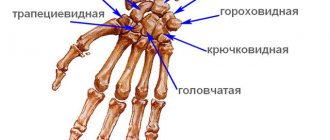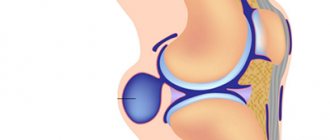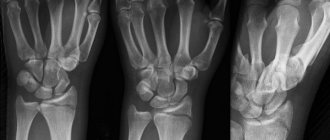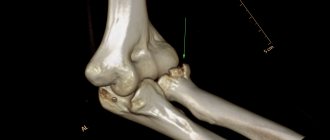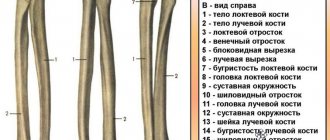| Flexor carpi radialis | |
| lat. Musculus flexor carpi radialis | |
| Flexor carpi radialis highlighted in blue | |
| Start | brachial bone |
| Attachment | II (III) metacarpal bone |
| Blood supply | a. radialis |
| Innervation | n. medianus (CVI-CVII) |
| Function | flexes and pronates the hand |
| Antagonist | Extensor carpi ulnaris |
| Catalogs | |
| |
| Media files on Wikimedia Commons | |
Flexor carpi radialis
(lat. Musculus flexor carpi radialis) - flat long-lasting muscle. Located lateral to all flexors of the forearm. In the proximal part, it is covered only by the aponeurosis of the biceps brachii and palmaris longus muscles, and the rest, most of the muscle, is covered only by fascia and skin. The muscle originates from the medial epicondyle of the humerus, the intermuscular septum and the fascia of the forearm. It goes down and passes under the flexor retinaculum to the base of the palmar surface of the II (III) metacarpal bone [2].
Causes of hand tendonitis
Wrist tendinitis (styloiditis) occurs against the background of other serious pathologies or develops as an independent disease.
The key factors that provoke the onset of the disease include excessive stress on the tendons.
For wrist tendinitis, as an independent pathological process, the following processes are characteristic:
- The appearance of mechanical damage that occurs against the background of prolonged physical activity;
- The occurrence of microtraumas, which is a consequence of tendon tension during physical exercise;
- Pathological processes that manifest themselves as a result of pathogenic bacteria entering damaged tissue.
Patients who have hand tendinitis due to other reasons often turn to medical care, including:
- Deterioration of metabolism;
- Incorrect posture;
- Degenerative processes in the joint area, which can be triggered by hormonal imbalances, metabolic failures, and increased stress;
- A number of diseases characterized by damage to periarticular tissues and joints;
- Infectious diseases caused by the penetration of pathogens;
- Malfunctions of the immune system associated with prolonged exposure to medications or colds.
Tendinitis of the hand is most common in males.
When drawing up a treatment plan, our specialists take into account not only the nuances of the development of the disease itself, but also the age characteristics of the patient, his lifestyle and gender. In case of diagnosing related processes, we are ready to apply an integrated approach based on the latest highly effective techniques.
Thanks to the constant improvement of professional skills, continuous scientific activity and interaction with large research laboratories, the staff of our medical center are able to put innovative therapeutic methods into practice.
Anatomy of the elbow
The everyday concept of “elbow” has two meanings - now this term usually refers to the area of the elbow joint, while previously the forearm was called the elbow - the area from the hand to the elbow (one of the length measures was “elbow”).
In anatomy, a distinction is made between the shoulder - the upper section of the free upper limb, which starts from the shoulder joint and ends at the elbow, the elbow joint itself, and the forearm. In this article we will analyze the anatomical structures of the musculoskeletal system that form and surround the elbow joint: the bones of the shoulder and forearm, the ligaments and joints of the elbow joint and the muscles of the shoulder and forearm.
Symptoms of hand tendonitis
The key nuances of wrist joint tendinitis include the localization of its symptoms in the area of inflammation. The primary stage of the disease is characterized by the following manifestations:
- Pain syndrome that increases during physical activity. Irradiation of pain can be observed in nearby areas;
- Crunching when making motor movements of a limb;
- Swelling in the joint area;
- Feeling of stiffness;
- In the area of inflammation, the temperature often rises;
- The appearance of dense formations under the skin.
If you have wrist tendonitis but other symptoms are present, the symptoms and treatment will also be specific.
The presence of hand tendonitis can be judged from the results of studies carried out using instrumental methods and in laboratory conditions. For this purpose the following are appointed:
- X-ray of the joint;
- General blood analysis;
- Study of the synovial fluid filling the joint cavity;
- Ultrasound, which allows us to exclude the presence of pathological processes in the joint area;
- MRI.
Medical specialists conduct a thorough study of the existing symptoms and determine the degree of joint mobility.
The key objective of our activity is to provide highly qualified services with a guarantee of long-term results. At the same time, you can always clarify information about the cost of future treatment and ask other questions that interest you.
Rib cage
The chest is formed by 12 thoracic vertebrae, 12 pairs of ribs and the sternum. The rib cage limits the chest cavity. Depending on the body type, the chest can have a different shape - flat, cylindrical, conical.
There are 4 walls in the chest: anterior, 2 lateral; 2 openings - the upper and lower apertures of the chest.
The upper aperture of the chest, aperture thoracis superior, is limited by the 1st thoracic vertebra, 1st ribs, and manubrium of the sternum.
The lower aperture of the chest, aperture thoracis inferior, is limited by the XII thoracic vertebra, the lower ribs and the xiphoid process of the sternum.
VII X ribs, connected to each other by costal cartilages, form the costal arch, arcus costalis.
The right and left costal arches limit the substernal angle, angulus infrasternalis.
Raising the ribs with inhalation: external interpersonal, scalene, superior posterior serratus muscles. With a fixed shoulder girdle, the pectoralis major and minor and serratus anterior muscles increase inhalation, and with the head thrown back, the sternocleidomastoid muscles increase inhalation.
The lowering of the ribs during a calm exhalation occurs without the participation of muscles due to the elasticity of the costal cartilages and costovertebral joints. When you exhale deeply, the internal intercostal and subcostal muscles, the transverse thoracic muscle, the serratus inferior muscles, and the abdominal muscles contract.
During abdominal breathing (in infants) and mixed breathing, the diaphragm plays an important role. Chest breathing without significant contractions of the diaphragm is observed in pregnant women.
Movements of the chest are combined with movements of the spinal column: when inhaling, the spine extends, and when exhaling, it bends.
Methods for diagnosing hand tendonitis
Determine the presence of tendinitis of the wrist joint after a thorough examination and palpation of the limb by a doctor. This makes it possible to identify the area of spread of the pathological process.
In addition, to differentiate the disease, the specialist asks the patient leading questions. Sometimes doubts arise regarding the specification of the affected area.
In order to determine infectious pathologies, studies are performed in laboratory conditions. In turn, X-ray examination allows identifying the presence of calcium accumulations. Ultrasound and MRI are indicated if the specialist suspects the presence of tears in the wrist area.
Make an appointment Online booking
- Clinic on Krasnopresnenskaya +7 (499) 252-41-35 Volkov lane, 21
- Clinic on Varshavskaya +7 (499) 610-02-09 Varshavskoe highway, 75, building 1
- Clinic in Annino +7 (495) 388-08-08 Varshavskoe highway, 154, building 1
Treatment of wrist tendonitis at various stages
When diagnosing the pathology of wrist tendonitis, treatment should be prescribed by an experienced specialist, taking into account the existing symptoms. As a rule, all doctor’s recommendations can be followed at home. Hospitalization is carried out only in advanced cases.
In addition to medications, hand tendinitis can be treated through massage and physiotherapeutic methods.
In case of acute manifestations of the disease, the patient is recommended to:
- Use cold compresses to relieve pain;
- Secure the joint with a special bandage;
- Use medications;
- Carry out physiotherapeutic procedures.
UVT for hand tendinitis
If you have been diagnosed with hand tendinitis, treatment can be performed using the latest technique - shock wave therapy. This is a modern, highly effective way to eliminate pathological processes in the area of tendon tissue, thanks to which you can easily deal with calcium deposits and avoid surgical intervention.
By using this method in the treatment of tendinitis of the hand, the following positive effects can be achieved:
- Break up calcium deposits;
- Normalize blood flow in the area of localization of pathology;
- Completely eliminate pain;
- Restore metabolism;
- Stop the pathological process;
- Restore motor activity and healthy tissue.
You can get the desired healing effect from the first sessions. Their frequency and intensity should be selected individually. However, in order to obtain a lasting therapeutic result in the process of shock wave therapy for tendinitis of the right or right hand, it is necessary to consult a specialist in a timely manner.
In our clinic, shock wave treatment is carried out using innovative Swiss equipment, which guarantees reliable and prolonged results, as well as an easy rehabilitation period.
How to treat hand tendonitis with medications?
If tendonitis of the wrist joint occurs, it is not possible to carry out effective treatment without the use of medications.
First of all, the patient is recommended to take medications that eliminate pain and reduce swelling. In this case, the best results are obtained by taking anti-inflammatory drugs.
The above medications are taken for at least two weeks. As a rule, after a course of treatment, all unpleasant manifestations disappear and the functionality of the hand is restored.
The necessary therapeutic effect can be obtained by taking the following medications:
- Ibuprofen;
- Ketoprofen;
- Piroxicam;
- Motrin;
- Indomethacin.
For the purpose of local anesthesia, Viprosal, Voltaren, Dolobene gels are applied to the affected area. The method of use is indicated in the instructions.
In case of infectious processes, antibacterial agents are used. If the immune system malfunctions, the specialist will prescribe steroid hormonal drugs.
Therapeutic exercises and massage for hand tendonitis
In order to prevent the development of the disease and quickly restore the functionality of the hand, special exercises are used. However, they can only be performed after pain has disappeared. Moreover, special emphasis is placed on the complex, which allows you to strengthen the muscles of the hand.
Daily exercise helps normalize blood circulation and restore metabolic processes. In this case, rotational movements, bending and stretching are performed. They have a powerful healing effect and help maintain muscle tone.
In addition, those diagnosed with wrist extensor tendinitis need to swim regularly.
If the pathology is chronic, resort to therapeutic massage. You can perform a special complex at home. For those who are interested in how to treat wrist tendinitis through massage, below we will give some recommendations:
- If you have tendinitis, you need to rub the sore spot with your thumb;
- Light stroking and patting movements are carried out in the affected area, as well as along the tendons.
Physiotherapy for wrist tendinitis
You can quickly restore the affected area through physiotherapeutic methods. They can be performed independently or as part of complex therapy - in addition to taking medications.
Thanks to physiotherapy, it is possible to improve metabolic processes and also ensure a rapid process of fusion of tendon fibers and resorption of dense formations.
Some of the most effective physical procedures include:
- Electrophoresis with lidase;
- Use of ultraviolet exposure;
- Magnetotherapy;
- Laser radiation;
- Ultrasound.
Traditional methods
For mild manifestations of the disease, you can use folk methods that can eliminate pathological processes in the affected area and relieve pain. Next you will get acquainted with several effective recipes:
- Consumption of curcumin. Allows you to eliminate pain and minimize inflammation. To achieve the desired effect, it is recommended to use seasoning - about 0.5 grams per day;
- A mixture of sarsaparilla and ginger. The raw materials are crushed, after which an infusion is made - 1 teaspoon of the contents is poured into 1 glass of boiling water. Take 2 times a day instead of tea. The action of the above mixture is aimed at relieving inflammatory manifestations;
- Bird cherry berries. Make a decoction: the raw material (3 tablespoons) is poured with 1 glass of boiling water. Take 2-3 times a day. Due to the presence of tannins in bird cherry, the necessary anti-inflammatory effect is achieved;
- Walnut. Add 500 ml of vodka to 1 glass of partitions. The contents are infused for about 20 days. The course of treatment reaches 1 month;
- Salty water. To prepare the product, take 1 tablespoon of salt and add water. Soak a cotton sponge in the resulting solution, wring it out lightly and place it in a bag, and then put it in the freezer for a few minutes. After removing the sponge from the bag, bandage it to the sore spot and keep it there until it dries completely.
Make an appointment Online booking
- Clinic on Krasnopresnenskaya +7 (499) 252-41-35 Volkov lane, 21
- Clinic on Varshavskaya +7 (499) 610-02-09 Varshavskoe highway, 75, building 1
- Clinic in Annino +7 (495) 388-08-08 Varshavskoe highway, 154, building 1
Surgery
If a patient has advanced tendinitis of the hand, which cannot be treated with ointments, anti-inflammatory drugs and physiotherapeutic methods, the only way out of the situation is surgery. Thanks to it, it is possible to remove adhesions and scars that usually accompany tendonitis of the extensor tendon of the hand.
Rehabilitation after treatment of hand tendinitis
An important part of therapy aimed at eliminating the consequences of tendinitis is the rehabilitation period. It includes therapeutic massage and special exercises. However, rehabilitation measures should be started only after pain has been eliminated and inflammation has been relieved.
The main goal of such exercises is to restore the elasticity of the tendons and strengthen the muscle tissue. At the initial stage, the use of special devices is not provided. Over time, they resort to using an expander.
As for massage procedures, they are carried out with the aim of improving regenerative processes in tissues, normalizing blood flow and improving the elasticity of tendons.
Connection of ribs to sternum
The I VII ribs (true ribs, costae verae) are connected to the sternum. The VIII, IX and X ribs (false ribs, costae spuriae) are connected by their cartilages to each other, and the cartilage of the VIII rib is connected to the cartilage of the VII rib. The XI, XII ribs are located with their anterior ends in the thickness of the muscles of the abdominal wall (oscillating ribs, costae fluctuantes).
The first rib is connected to the sternum using the sternocostal joints, art.sternocostales.
The sternocostal joint is formed by the cartilage of the rib and the costal notch of the sternum. The joint is flat.
Ligaments that strengthen the joint: a) Radial sternocostal ligament, lig.sternocostale radiatum. ,) Intravascular sternocostal ligament, lig. sternocostale raarticulare - this ligament is well expressed only in the joint of the 2nd rib. c) On the anterior surface of the sternum, the radiate sternocostal ligaments fuse with the periosteum and form the sternum membrane, membrane sterni.
Is it possible to return to sports activities after tendinitis?
In case of relapses after wrist flexor tendonitis or other varieties of this disease, the doctor may advise you to avoid sports that involve excessive stress on the hand. But with positive dynamics after treatment, there are no restrictions for resuming sports activities.
For preventive purposes, when performing sports exercises, it is advisable to use a bandage, which will minimize the load. It is also mandatory to stretch the muscles of the hand before and during sports. After training, you need to take a salt bath.
Flexor carpi radialis and palmaris longus[edit | edit code]
Flexor carpi radialis (1) and palmaris longus (2)
Flexor carpi radialis
(
m. flexor carpi radialis
) flexes the wrist joints or causes radial abduction of the hand. In addition, like the flexor carpi ulnaris, it transmits the pull of the long extensors to the finger joints by fixing the wrist joints.
Palmaris longus muscle
(
m. palmaris lopgus
) - a very weak flexor of the forearm and a weak flexor of the wrist joints. It pulls on the palmar aponeurosis and tenses when the tips of the thumb and little finger are brought together.
Home[edit | edit code]
- Medial epicondyle of the humerus
- Fascia of the forearm
Attachment[edit | edit code]
- Flexor carpi radialis: palmar surface of the base of the second metacarpal bone, sometimes the third metacarpal bone
- Palmaris longus muscle: palmar aponeurosis
Innervation[edit | edit code]
- Flexor carpi radialis: median nerve, C6-C8
- Palmaris longus: median nerve, C7-T1
